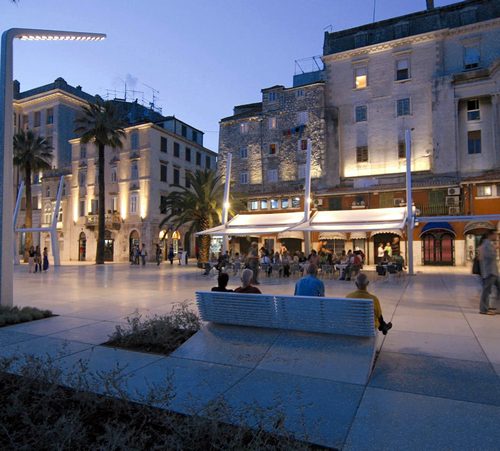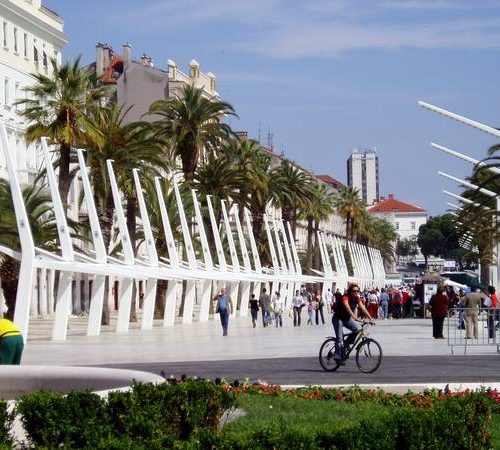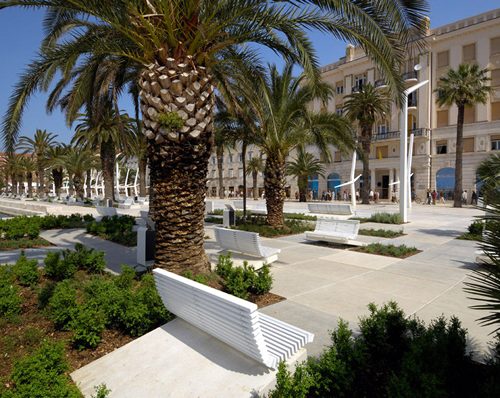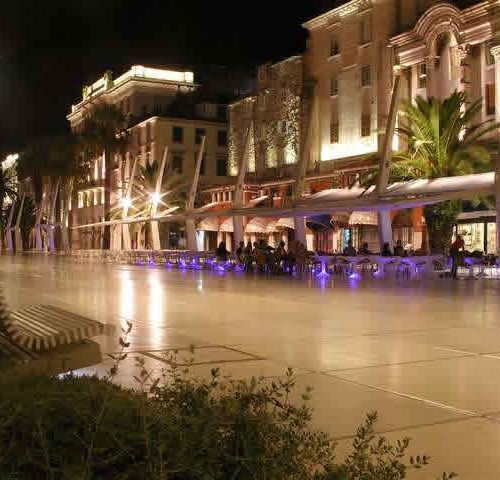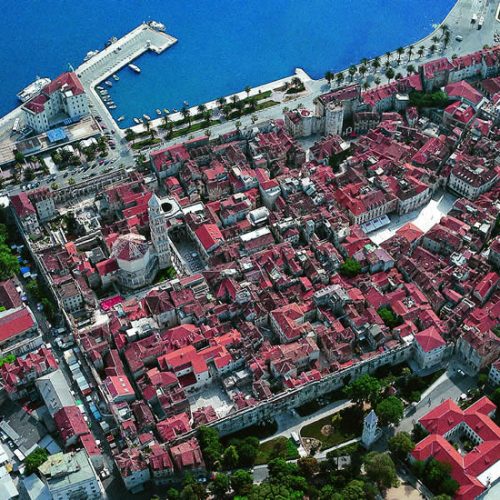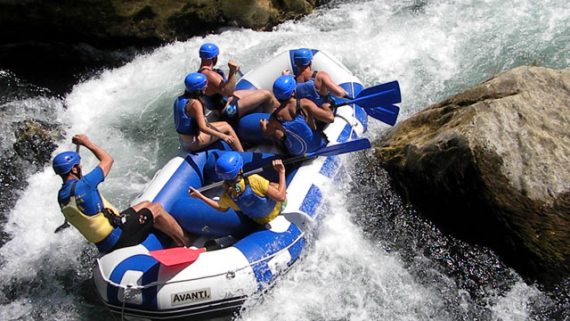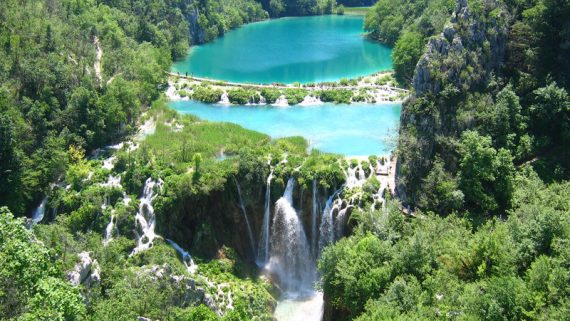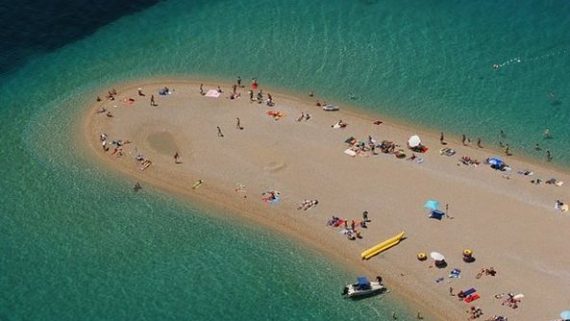SPLIT
- Split is a Mediterranean city, situated on the Marjan peninsula at the centre of the eastern Adriatic coast. Because of its favourable geographical position, Split has a typical Mediterranean climate, with long, dry, warm summers and short, mild, rainy winters (yearly average of 900 mm of rain). The average summer air temperature in Split is 26°C (79°F), with 12 hours of direct sunlight (year-round average of 7 hours).
Split is the cultural and political centre of Dalmatia (a historical region, once much larger, now stretching from the city of Karlobag further north along the coast to the Cape Prevlaka near Dubrovnik), and is the official seat of the Split–Dalmatia County. Approximately 180 000 people live in Split, making it the second-largest city in Croatia.
The official history of Split stretches back for 1700 years, when the Roman emperor Diocletian built his palace (emulating the form of the Roman military camp) as a place to which he would retire after stepping down from the imperial throne. However, preceding Diocletian’s palace, the site held the Greek colony Aspalathos, meaning the plant called Spanish or weaver’s broom (Spartia juncea). The plant is still numerous, especially on the southern slopes of the park-forest Marjan.
- Geographical position
Split lies on the Adriatic coast, central Dalmatia, on the Split (Marjan) peninsula. Although surrounded by sea as a peninsula, Split also borders with surrounding mountains, Mosor on the northeast, Kozjak on the northwest, and Marjan hill as one of the most important symbols of the city, rising on the west side of the peninsula, in the immediate vicinity of the old city centre. Split is also surrounded by the islands Brač, Hvar, Šolta and Čiovo. Split is the largest city in Dalmatia, second largest city in Croatia and according to the latest census conducted in 2011 Split has almost 180 thousand inhabitants. Second largest Croatian cargo harbour, but also one of the largest passenger harbours on the Mediterranean. It is the administrative centre of the Split & Dalmatia County.
ClimateSplit has a Mediterranean climate, characterized by dry and very hot summers and cool, but moderate and humid winters. Average temperature of the warmest month of the year is 22°C, and the coldest 4°C.
Split through the seasonsThanks to the Mediterranean climate, winters are mild in Split, lasting from December to March, although the actual experience of winter can really be felt only in February. For this reason all the comforts of Split can be savoured for most of the winter, from sightseeing the Diocletian Palace to the tastings of all the delicacies in numerous restaurants, and at the Christmas fair on the Riva during the entire December Christmas holidays. It is not even so unusual to spend sunny winter mornings sitting on the café terraces. Spring in Split lasts from March to June, and it is one of the best seasons to visit Split. The average temperature is the ideal 20°C, abundant in sunny periods ideal for walking on Marjan, excursions, and even swimming in the late spring. During this season Split begins its life in the open, it is the waking moment of its streets and city squares. Although high temperatures characterize the summer in Split, sometimes even over 35°C, spreading from June to the end of September, you can find refreshment in the beautiful Adriatic sea on many of Split’s beaches or on the nearby islands, while during the summer nights you can unwind through different events, such as the Days of Diocletian, Split summer festival and many others, where everyone can find something for themselves, and where you will experience a true Mediterranean hustle and bustle. Autumn in Split lasts from September to December, although not a favourite part of the year to some, in many ways it is the most beautiful time of the year to visit Split, especially at the end of September and in October. It is the time when the temperature of the sea is ideal, the summer heat is at its low, and the main season is still on.
- The history of Split is over-flowingly rich and turbulent to fit in just a couple of sentences. Although the Split area was earlier inhabited by the Greek colonies, Emperor Diocletian should be considered its first citizen and founder, starting his lavish villa of around 300 square meters near the great city of Salona in 293 AD, only to retire from the Roman throne within its walls after building it for ten years. Turbulent centuries that followed turned the villa into a city, conceived by the fugitive inhabitants of Salona who fled from the Avars and Slavs. Many authorities changed hands in the city which, in the years to come, grew beyond the Palace walls, from the Croatian Kings in the 10th century, through the Hungarian and Venetian administration, to the French rulers and the Austro-Hungarian monarchy. Modern age and the 20th century “moved” Split from the kingdom of Yugoslavia, through tragic, yet heroic times of the Italian and German occupation during the Second World War when Split was one of the centres of anti-fascist resistance, to the Socialist Yugoslavia and the present period of the free and independent Croatia, member of the European Union. Tumultuous history leaves its trace in the everyday life of the city that always moved steadily forward, remaining the centre of this part of the coast to this day. In those mixtures of history layers, clumsiness was inevitable, sometimes even rashness in development, but today it is all a part of its originality. Great city beats today with the silent whisper of history, the lively spirit of youth and charm of the Mediterranean yet in every way also Croatian warmth…
SURROUNDINGS
The Vranjača cave is made up of two chambers. The first, the existence of which was already known in the 19th century, has no stalactites. The second was discovered in 1903 by Stipe Punda, who was the owner of this plot of land. This part consists of a system … Read More
Solaris Beach Resort is a unique tourist complex in Sibenik. It’s best known for 5 thematic beaches that stretch over four kilometers long coast. Surrounded by beautiful Mediterranean vegetation it provides comfortable accommodation in a great location, many attractions and modern interior. The offer of the resort includes 5 … Read More
Town history
Writing a brief summary of the history of Solin, formerly the capital of a Roman provinence and describing its improtant monuments, is a task both appealing and hard. It is well known that Salona disappeared at the end of classical epoque, never to be renewed again. In the … Read More
Primosten is one of the most popular tourist resorts in Dalmatia (tourism has been developing in an organized way since the sixties) and ranks among the most picturesque small towns on the Adriatic, with a number of typical narrow streets in the old town core on a small, hilly … Read More
Grad jedinstvene političke i kulturne povijesti (Dubrovačka Republika, Gradski statut iz 1272.), svjetski poznate spomenične baštine i ljepote (upisan u UNESCO-ov registar svjetske kulturne baštine).
Dubrovnik je jedan od najatraktivnijih i najpoznatijih gradova Sredozemlja. Uz izuzetne prirodne ljepote i očuvanost baštine, Dubrovnik je grad iznimno bogate turističke ponude.
Grad hotela, prelijepe … Read More
Rafting: Kao spoj avanturizma sporta i zabave doživio je svoj najveći procvat bas tu, u Omišu. Rijeka Cetina i njen kanjon začudne ljepote pružaju nezaboravan doživljaj i opravdavaju epitet Omiša kao najboljeg mjesta za rafting; kako za početnike tako i za stare zaljubljenike u taj sport.
Ne morate pobjeći daleko … Read More
The best and most among the eight national parks in Croatia – Plitvice Lakes, is only natural, cultural values in society, in included in the World Heritage List (UNESCO) and 1979. Was among the first in the world.
According to the IUCN, which defines eight categories of protection of natural … Read More
Medjugorje is one of the most famous Catholic shrines in the world, located near the town Èitluk, in the southern part of Bosnia and Herzegovina. It has about 4.300 inhabitants, and became famous for the apparitions of the Virgin Mary, which first started in 1981st year. Since then this … Read More
Welcome to Hvar, an ancient city with a rich history. Many will say that is a fairytale town – with its architecture, beautiful nature and mild climate.
Natural charm together with high quality accommodation and Mediterranean cordiality and courtesy city of Hvar becomes an ideal holiday destination for couples and … Read More
National Park “Krka” 1985th year. and is the seventh national park Croatian.
It is located entirely within the territory of Sibenik-Knin County and encompasses an area of 109 km2 along the Krka River: two kilometers downriver from Knin to Skradin and Čikole.
From the flooded part of the mouth, it is … Read More
In the central part of the Croatian Adriatic, between Sibenik and Zadar town, there is a separate and amazing group of islands named Kornati.
Because of the beauty, interesting geomorphology, indented coastline and rich marine life, the 1980th most of the Kornati archipelago was declared a national park.
Today the National … Read More






